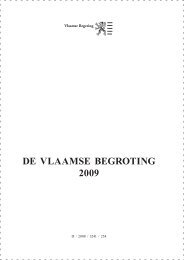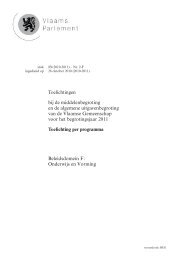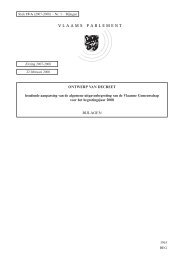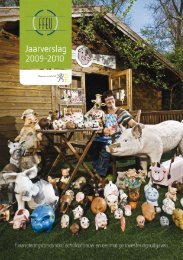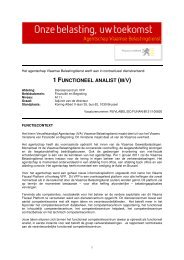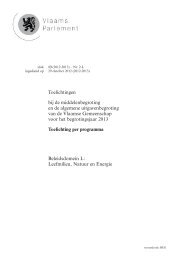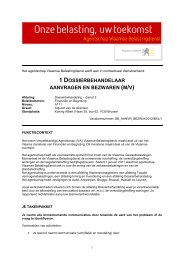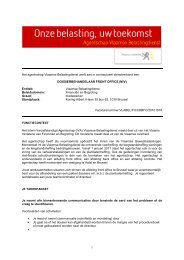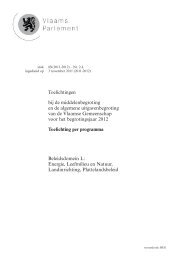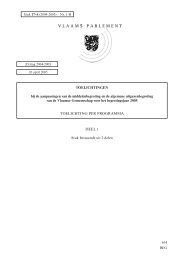Knowledge-based economy - Flanders Investment & Trade
Knowledge-based economy - Flanders Investment & Trade
Knowledge-based economy - Flanders Investment & Trade
Create successful ePaper yourself
Turn your PDF publications into a flip-book with our unique Google optimized e-Paper software.
<strong>Flanders</strong>A knowledge-<strong>based</strong> <strong>economy</strong> in a top locationEurope’s best business locationGovernment of <strong>Flanders</strong> - Belgium
Dublin•London•Amsterdam••BrusselsParis••Bruges•Ghent•AntwerpF l a n d e r sBrussels Leuven•••HasseltZurich•Lisbon•Madrid•
OsloCopenhagenBerlinPragueViennaRome
<strong>Flanders</strong>A knowledge-<strong>based</strong> <strong>economy</strong>in a top location
<strong>Flanders</strong>A knowledge-<strong>based</strong> <strong>economy</strong> in a top locationBrugesAntwerpGhentHasseltLeuvenBrussels<strong>Flanders</strong> <strong>Investment</strong> & <strong>Trade</strong> thanks all companies and organizations that provided information and photographs for this brochure.
www.flandersinvestmentandtrade.com6 About <strong>Flanders</strong>Europe’s best business location8 Markets and suppliersThe right infrastructure12 Focus on the logistics industryThe right place to be14 Focus on the automotive industryA dynamic past... A dynamic future16 Focus on the chemicals industryEurope’s leading production base18 The right peopleProductive, highly educated & multilingual: A quality workforce20 Focus on technology clusters22 Research and innovation<strong>Knowledge</strong>, support, focus and specialties26 Innovators through the AgesFrom maps & plastics to biotech & the ‘cyber élite’28 Focus on the life sciencesInnovation & experience, research & expertise30 Focus on the food industryTradition & technology, production & logistics32 LifestyleQuality & tradition: The feel-at-home factor for expat families34 The heart of Europe36 <strong>Flanders</strong> <strong>Investment</strong> & <strong>Trade</strong>Expert advice & assistance, free of charge
About <strong>Flanders</strong>Europe’s best business locationFor businesses looking to establish or expand operations in Europe,the region of <strong>Flanders</strong> provides a prime location <strong>based</strong> on a dynamic,knowledge-<strong>based</strong> <strong>economy</strong>.Combining all the benefits of its position at the hub of Europe’swealthiest zone and at the heart of European decision-making,<strong>Flanders</strong> provides a virtually unequalled quality of infrastructure inboth transport and communications.Its leading sectors include the logistics, automotive, chemicals,food and life sciences industries along with a dynamic hightechnologysector that ranges from ICT and telematics throughsignal processing, nano-electronics and nanotechnology. Leadingedgeclusters associated with specialized research institutes andthe universities have developed to support, develop and providesynergy in innovation and R&D.Businesses in <strong>Flanders</strong> also benefit from a quality workforce in anenterprise culture. The workforce is among the world’s mostproductive and multilingual, and is also well educated and highlytrained.<strong>Flanders</strong> offers business an ideal location in today’s global<strong>economy</strong>:The right placeThe right infrastructureThe right peopleA modern, knowledge-<strong>based</strong> platform for growth.6
A strong businesstraditionFor centuries <strong>Flanders</strong> has occupied acrucial position and played an importantrole at the crossroads of Europeantrade.In the early Middle Ages the city ofBruges was a major focus of Europeancommerce and by the 14th century it hadthe world’s first stock exchange. By the16th century the focus had switched toAntwerp with its thriving seaport and apopulation of more than 100,000 people.Situated right at the point where Europe’sthree major cultural and linguisticgroupings meet, <strong>Flanders</strong>’ modern<strong>economy</strong> has built on the business andtrading tradition established over thecenturies.Heart of EuropeThe location of <strong>Flanders</strong> puts it right atthe hub of Europe’s wealthiest area andright at the heart of European decisionmaking.The region’s immediate neighborsare the Netherlands, Germany,Luxembourg, France and just across theChannel, the UK.The capital of <strong>Flanders</strong> is Brussels,headquarters to the European Union,NATO and a large number of internationalgovernmental and non-governmentalorganizations as well as corporaterepresentative offices and treasuryoperations.As the northern region of Belgium,<strong>Flanders</strong>’ currency is the euro whichprovides distinct benefits for companieswith pan-European operations andparticularly those within the “eurozone”.7
Markets and SuppliesThe rightinfrastructure<strong>Flanders</strong> provides businesses with auniquely central location at the hub ofEuropean trade and the heart ofEuropean decision-making. <strong>Flanders</strong> isalso at the center of the wealthiest andmost populated area of Europe andprovides businesses with rapid accessto leading markets and suppliers.Transport and communications infrastructuresare highly developed.Roads into EuropeA planned and efficient road and freewayinfrastructure enables businesses tomake the most of <strong>Flanders</strong>’ centrallocation. With one of the highest densityroad networks in the world, the freewaysystem in <strong>Flanders</strong> connects directlywith those of France, The Netherlands,Germany and Luxembourg, as well as byferry or Channel Tunnel (via France) withthe UK.Logistics operations are able to movegoods from <strong>Flanders</strong> to most majorEuropean markets by road within 24hours. Amsterdam is just 248 km away,London 320, Paris 336 and Frankfurt344. In <strong>Flanders</strong> the ports, rail depotsand airports are well-sited for quickaccess to freeways, while industry andtechnology zones have been located withaccessibility in mind. In total, Belgiumhas more than 9,000 truckingcompanies, with some 70% of these<strong>based</strong> in <strong>Flanders</strong>. A number operateregular services to and from a widerange of European centers.Efficient rail systemThe Belgian railway freight system (B-Cargo) is modern and highly developed,offering tailor-made solutions for goodsdestined for all parts of Europe. Inaddition to carrying some 178 millionpassengers a year, the railway networkalso handles around 60 million tons offreight.B-Cargo offers daily EurailCargotransport to and from Europe’s majoreconomic zones. Rapid transit andreliable on-time arrivals are key parts ofthe service offered. The Hermesinternational communications andtracking system enables B-Cargo’s staffto keep customers informed of ashipment’s progress and services aretailor-made to meet consignmentrequirements. B-Cargo also offersservices <strong>based</strong> on a multi-functionalplatform concept, combining rail androad transport. The system is flexibleand can meet the full logistics needs of aclient. In addition to loading andunloading, services extend to storage,road transport to or from the railwayand final distribution.8
Markets and SuppliesWaterway optionsTransport by inland waterways continuesto increase year on year as a reliable andcost-effective means of moving bulkgoods within Europe. The ports aremajor drivers in the rise, while a numberof large companies situated along thewaterways are increasingly turning tocanal transport and investing in theirown quay facilities.The European Union inland waterwaynetwork consists of some 30,190 km ofcanals and rivers with 20,215 kmconcentrated within the busiest part ofthe network. This includes Belgium,Germany, France, the Netherlands andAustria. The EU fleet includes almost9,000 dry cargo vessels, 1,420 tankvessels and some 830 barge tugs.These vessels range from containercarriers of up to 140 meters, throughroll-on-roll-off car carriers to smallerclasses. The network in <strong>Flanders</strong> ismade up of eight inland waterwayterminals, all with efficient links withother transport systems, including railand road.Ease of business travel<strong>Flanders</strong> meets the needs of businesstravel with frequent and efficientconnections to other European andworld cities. Within Europe, there is theoption of using air services throughBrussels International Airport or makingthe journey by high-speed train.Located at Zaventem, just 16 km fromthe center of Brussels, the city’sinternational airport offers a variety ofEuropean and international flights withmost European destinations within twohours’ flying time. The smaller DeurneAirport at Antwerp offers businesstravelers passenger flights to a limitednumber of European destinations.Both Brussels and Antwerp are onEurope’s high-speed train network andoffer services or connections to 19 othercities on the high-speed system.Eurostar takes less than three hours toLondon with some 10 services a dayfrom Brussels. Thalys connectsBrussels and Paris in one hour 25minutes and operates through Antwerpto Amsterdam as well as to other citiessuch as Cologne. Eurostar and Thalysboth offer corporate programs forbusiness travel.10
Reliable communicationsThe communications infrastructure in<strong>Flanders</strong> is highly developed and offersall the connectivity, reliability, securityand choice that companies need.Brussels is among the world’s Top 10Internet hubs and Top 20 telecom hubs.In telecoms there are a range ofcompanies and options available in boththe fixed line and mobile fields. Since thefreeing-up of Europe’s telecoms marketsmore than five years ago a considerablenumber of leading internationaloperators have moved in and, togetherwith locally <strong>based</strong> firms, provide a fullrange of global services.<strong>Flanders</strong> has been a leader in broadbandpenetration for a number of years withthe initial burst mainly <strong>based</strong> on the factthat virtually all homes are equippedwith cable. Today, the region remains atthe forefront. According to Eurostat 2005figures, 96% of Belgian companies areInternet-connected (70% broadband)compared with the European Unionaverage of 89% (53% broadband).11
FOCUS onRanked first for access tothe EU coreThe right place to beThe logistics industry is a major investorand employer in <strong>Flanders</strong>, and with goodreason. The region is not only located atthe heart of Europe’s core <strong>economy</strong>, butalso has the expertise, the modernmultimodal infrastructure and the rangeof languages required to support valueaddeddistribution operations throughoutthe Continent. <strong>Flanders</strong> is the gatewayto the European market.With three of Europe’s leading ports(Antwerp, Ghent and Zeebrugge), twoairports (Brussels and Ostend), anextensive inland waterway system and ahigh density of both road and railnetworks, a base in <strong>Flanders</strong> meansEurope’s major industrial centers arenot far away in terms of time. In addition,<strong>Flanders</strong> is located at the heart of theEuropean Union’s wealthiest zone.<strong>Flanders</strong> is consistently ranked highly instudies of the best locations for Europeandistribution centers. Cushman &Wakefield’s European DistributionReport 2006 ranked Belgium theleading country in which to establish apan-European distribution hub. Theranking, <strong>based</strong> on a matrix of the relativestrengths and weaknesses of 16 majorEuropean countries, saw Belgium scorewell in a number of vital fields –occupancy costs, road density, roadcongestion, rail density, sea freight,population density and built new units.In “access to the EU core” it was rankedfirst.With the growth of the logistics sector inthe region, the Flemish Government hasestablished a non-profit organization tosupport and strengthen the logisticsindustry. The <strong>Flanders</strong> Institute forLogistics (VIL) started in May 2003 toreinforce the competitiveness of thelogistics sector in <strong>Flanders</strong> throughinnovation, knowledge gathering andtransfer, promotion, networking andadvice. Today VIL is running a number ofinnovative logistics projects and workswith <strong>Flanders</strong> <strong>Investment</strong> & <strong>Trade</strong> tofacilitate investment in <strong>Flanders</strong>.12
The Logistics IndustryCross-sector operationsLogistics in <strong>Flanders</strong> extend across awide range of sectors and include bothin-house and third-party specialists,basic warehousing and dispatch throughto high-level value-added operations.Warehousing and dispatch operationsrange from traditional pick-and-packtypes through robotic e-logistics thatextend all the way through the supply,production, warehousing, postponedmanufacturing, dispatch and documentationchain.Logistics operations <strong>based</strong> in <strong>Flanders</strong>range across most sectors – from foodand healthcare products through toautomotive and electronics, fromclothing to chemicals. In the food sector,leading names include Tropicana andProcter & Gamble, for example. Inhealthcare, Janssen Pharmaceutica(Johnson & Johnson), Pfizer, Schering-Plough and Becton Dickinson amongothers have major operations. Theautomotive industry is well represented,with Ford, Opel, Volkswagen and Volvoall running assembly lines in the region.In addition, logistics operations includeHonda, Hyundai, Komatsu, Mazda, andToyota. Bridgestone also has anexpanding European operation at thePort of Zeebrugge.More than 400 EDCsMore than 400 European DistributionCentres (EDCs) such as Nike, havechosen <strong>Flanders</strong> as the ideal location todistribute from. The existing know-howin this area provides a unique valueproposition.Third-party logistics service providersinclude global and local players such asCaterpillar Logistics, Essers Group,Hessenatie Logistics, Katoen Natie,Furness Logistics (Frans Maas), NYKLogistics, Exel, DHL, SKF, Kuehne +Nagel, Salvesen and others.The location, expertise and infrastructurein <strong>Flanders</strong> means that thisimportant sector will continue to expand– serving Europe via its freeways,railways, ports, airports, inlandwaterways and short-sea shippingservices.13
FOCUS onA dynamic past...A dynamic future<strong>Flanders</strong> has built a strong reputationas a high-quality automotive regionthroughout the industry. For more thana century, cars, buses, trucks and othertypes of vehicles have been produced inthe region and many suppliers havemade this part of the world their home.Today, that tradition continues, but thereis much more than simply the productionof components, parts and vehicles. Inaddition to company R&D divisions in theregion, there are other initiatives indesign, research and productdevelopment. These include <strong>Flanders</strong>Drive, a state-of-the-art testing centrethat includes a test track. And, buildingon their materials and engineeringdepartments, universities have developedbachelor and masters programsin automotive engineering. In total, theindustry in <strong>Flanders</strong> employs more than100,000 people.Four car plantsThe assembly industry produces some900,000 cars a year, with the figureexpected to rise as new models appearon the lines. Ford’s plant at Genklaunched production of the company’snew Sports Activity Vehicle and theGalaxy early in 2006. Production of thenew Mondeo is scheduled for 2007. Volvois producing four models – the S40, V50,V70 and most recently the C30 compactsports coupé – on two platforms at itsGhent plant following an extensiveexpansion program.General Motors produces all currentmodels of the company’s Astra range atits plant in the Port of Antwerp. Inaddition to the five-door and stationwagonmodels, the Astra GTC (GranTurismo Compact) was added in 2005and production of the Coupé Cabrio wasalso planned. Volkswagen’s plant atVorst in Brussels has been a long-termproducer of the Golf and this traditioncontinues.Trucks, buses and specialvehiclesThe Volvo Europa Truck plant at Ghent isthe largest facility of its type within theVolvo-Renault Group and produces morethan 30,000 trucks a year in addition toperforming design work. Its modelsinclude the company’s FL, FM and FHranges.Two bus manufacturers within the regiondevelop and produce more than 5,000buses and coaches each year. Van Hool,the larger of the two, exports around80% of its production and its luxurymodels have been ranked among themost popular in the USA. VDL Jonckheereassembles around 500 luxury unitseach year for export.14
The Automotive IndustrySpecial vehicle manufacturers includeMol, which produces all types of unitsranging from anti-riot trucks to cementmixers and airport apron vehicles. In2002 JLG Industries opened a newproduction facility in <strong>Flanders</strong> and nowproduces units such as telehandlers,scissor lifts and articulating boom liftsfor the European market. In the transitsystem market, Bombardier has a trainand tram manufacturing plant atBruges.Components andsuppliersIn the components sector, both DAFTrucks and Honda manufacture parts in<strong>Flanders</strong>, with DAF producing cabs andaxels at its plant in Geel. Some 290companies make up the supply industryand major international names includeBekaert, Dana Spicer, Johnson Controls,LMS, Nitto Europe, Recticel RobertBosch, Tenneco Automotive and TIAutomotive.LogisticsMany of the automotive industry’slogistics operations in <strong>Flanders</strong> arefocused around the three main ports.The Port of Zeebrugge handles some 1.8million new cars a year and leads Europein this sector. Quality control and predeliverywork form part of the addedvalue offer. The Port of Antwerp, hometo the General Motors production facility,handles around 800,000 new vehicleseach year, while the Port of Ghent ishome to the Volvo Cars, Volvo Trucksand Honda logistics operations.A large number of manufacturers,including names such as Hyundai, Isuzu,Komatsu, Mazda, Subaru and Toyota,have European Distribution Centers(EDCs) in <strong>Flanders</strong> and meet just-intimeorder demands across theContinent. The EDCs are operated by thecompanies themselves or by specialistthird-party providers.Bridgestone has its pan-European tirelogistics base at the Port of Zeebruggeand in 2005 began construction of asecond expansion of 31,500 squaremeters to its distribution center.15
FOCUS onEurope’s leading production baseDiversity & integration,location & logistics<strong>Flanders</strong> offers chemical companieslooking to expand into Europe or expandEuropean operations one of the largestand most highly developed chemicalsclusters in the world. Major names withproduction bases in <strong>Flanders</strong> includeBASF, Bayer, BP, Degussa, Ineos,Kaneka, Kuraray, McBride, Monsanto,Nippon Shokubai, Solvay andTessenderlo Chemie.In logistics, <strong>Flanders</strong> offers the pipelines,the road, rail, sea and inlandwaterway connections the chemicalssector requires. And, with severalclusters in addition to Antwerp, thereare specialist tank storage and serviceproviders close at hand.The Port of Antwerp:More than 300 differentchemicalswww.portofantwerp.comThe chemicals sector in <strong>Flanders</strong>extends along a ribbon from West<strong>Flanders</strong> and Ostend down throughGhent to Antwerp and from there alongthe Albert Canal to Tessenderlo. But it isthe Port of Antwerp that provides thefocus for an industry with some 500companies, 65,000 jobs and an annualturnover amounting to around 30 billioneuro.The growth of Antwerp as a clusterstretches back half a century. Today theport has five refineries, including two ofEurope’s Top 10 units, and four crackersproducing almost two million tons ofethylene a year (9.2% of Europeancapacity). Propylene production is some1.7 million tons, butadiene 303,000 tons,benzene 680,000 tons, toluene 100,000tons and xylene 55,000 tons. In total,companies within the port cluster areproducing more than 300 differentchemicals.Companies within the Antwerp chemicalscluster gain immediate advantagesfrom the cluster effect. They are able tointegrate their operations with those ofother companies, particularly suppliers,in a stable business and productionenvironment.16
The Chemicals IndustryIn infrastructure terms, the presence ofa large cluster means that energy, utilityand transport facilities are available andthat specialized logistics serviceproviders and equipment are close athand.The port is the major hub of the WesternEuropean pipeline system and, inaddition, Antwerp’s own pipelines arethe main transport mode for productexchanges. Combined with a leadingEuropean rail terminal, the proximity ofa major European freeway exchange,direct links into the European inlandwaterway network and the fact that theport is among the world’s Top Five,companies within the cluster are able tobenefit logistically from the ideal location<strong>Flanders</strong> offers in relation to marketsacross Europe.Ribbon effectThe fact that Antwerp is at the center ofthe <strong>Flanders</strong> chemicals ribbon and thatdistances are relatively short and wellservedlogistically means that companiesat other points along the ribbon are ableto benefit from the cluster advantages.Sites and co-sitingA range of greenfield sites are availableboth in Antwerp and at other placesalong the ribbon. In addition, fourcompanies provide co-siting options. Atthe Port of Antwerp there are three suchopportunities with BASF, Bayer andIneos, all of which offer a full range ofcooperative possibilities. At the Port ofOstend, the Plassendale chemicals site,owned and operated by Proviron, alsoprovides co-siting options.17
The Right PeopleProductive, highly educated & multilingual:A quality workforceA leader in productivityThe workforce in <strong>Flanders</strong> hasconsistently been ranked as one of themost productive in the world by a numberof different organizations.The OECD’s report “Estimates of LaborProductivity for 2004”, published in July2005, underlines the fact that this trendis continuing, with Belgium outperformingthe USA and virtually allother European economies in GDP perhour worked. The survey, with USproductivity as the base at 100, setBelgian productivity at 113 in GDP perhour worked. The G7 average was 92,the “euro zone” average 91 and the NorthAmerican average 84. In addition, theannual average of hours worked inBelgium was relatively high at 1522.The IMD “World CompetitivenessYearbook 2006” also places Belgiumabove the USA, Japan, the UK, theNetherlands and Germany on GDP perhour worked.18
Highly educatedThe education system in <strong>Flanders</strong> meetsthe needs of a competitive <strong>economy</strong>. Theschool leaving age is 18, and 38% ofpeople aged 25 to 34 have continuedtheir education at a university or otherhigher education establishment. Inaddition, Belgian students benefit froma lower pupil to teacher ratio than dothose in most other countries.According to the OECD’s PISA survey oflearning across 41 countries, 15-yearoldsin <strong>Flanders</strong> are the world’s best inmathematics. The study, published inDecember 2004, showed that Flemish15-year-olds achieved an overall averagescore of 533 in the mathematics survey,with Hong Kong just behind. In thesciences, the Flemish were ranked fifth,while in “problem-solving” they againbelonged to the top group.Multilingual populationThe Flemish people are among Europe’smost multilingual, an important aspectof doing business in today’s international<strong>economy</strong>. The region’s location at themeeting point of Europe’s three majorcultures and language groups - Anglo-Saxon, Germanic and Latin – has meantthat the Flemish people have had toaccommodate additional languages forcenturies. In addition, Belgium itself hasthree official languages (Flemish,French and German) with English ratingas a “virtual” fourth.Loyal and flexibleThe workforce in Belgium and <strong>Flanders</strong>is loyal to employers, a fact underlinedby surveys that show one of the world’shighest number of years in a businessrelationship. An International LaborOrganization survey published in 2001showed the Belgian loyalty rate to be11.3 years, the same as the rate recordedfor Japan.A modern infrastructure and flexiblelabor organizations in <strong>Flanders</strong> meanthat few days are lost to industrialdisputes. As a region, <strong>Flanders</strong> has notexperienced a major dispute since the1980s. In addition, absenteeism as apercentage of hours normally workedwas the lowest in the European Union at0.9% in a Eurostat survey of 2001.The geographic location of <strong>Flanders</strong> andits position at the crossroads of Europeantrade for centuries have brought all thebenefits of flexibility together with awillingness to adapt to new ways of doingthings and an enthusiasm for newtechnologies. Combined with atraditional ethic of hard work andinnovation, this has resulted in today’sdynamic and productive businesssector.An OECD survey published in the mid-1990s showed that 90% of Flemishpeople speak one foreign language, 80%speak two and 55% speak three - inaddition to their own. <strong>Flanders</strong> alsoscores particularly highly in TOEFLtests.19
FOCUS onLeading-edge dynamicsThe ICT industry in <strong>Flanders</strong> is a dynamicone and is among the world’s leaders ina number of fields, including bankingsystems, signal processing, microelectronicsand nanotechnology.Many of the companies in specialistfields have grouped together close touniversities or research institutes andcluster organizations have beenestablished to assist with synergy andexchange of information. The technologyclusters close to Leuven University areamong Europe’s highest spenders onR&D on a per employee basis.Clusters include DSP Valley withmembers such as Acunia International,Barco and Target Compiler Technologies,and a telematics grouping ranging fromtechnology developers and suppliersthrough to operators, integrators andthe knowledge institutes such asuniversities.<strong>Flanders</strong> Multimedia Valley is a virtualcluster of around 100 businesses andorganizations active in online andoffline multimedia production, contentand application development, Internetservices and e-business & e-government.The Flemish Innovation Center forGraphic Communication (VIGC) aims toprovide members with information toenhance their product and processinnovation. Strategic partners includeAgfa, Creo, Esko-Graphics, Plantin-Heidelberg, Kodak Polychrome Graphics,MAN Roland Belgium, Océ, and StrobbeGraphics/Xeikon International.Digital & embeddedsignal processingThe signal processing industry in<strong>Flanders</strong> is an expert knowledge clusterthat interlinks and networks companies,research institutes, universities andpolytechs. There are more than 5,000design engineers working within itsvarious organizations.Aiming to provide complete solutions,members also offer world-classproducts and design services for analogand mixed signal processing rangingfrom CMOS imaging sensors and otherdata acquisition building blocks, overhigh data rate Radio Frequency (RF)front-ends, to performant Analog-to-Digital Convertors (ADC).Expertise in the cluster’s businessesand research institutes includes microand nano electronic design, targetingcomplex on-a-chip (SOCs) and systemsin-a-package(SiPs), optimizing forultra-low-power and combining withthe related embedded softwaredevelopment.Members of DSP Valley include AnSem,ARM, Barco, Cypress Semiconductor,Medtronic, Philips, Septentrio, Siemens,Target Compiler Technologies andTelindus. In the same cluster aroundLeuven are also Melexis, OptionInternational, ST Microelectronics andmany more.20
Technology Clusterswww.imec.beIMEC - A world leaderin nano-electronics andnanotechnologyIMEC is an independent institute <strong>based</strong>at Leuven, <strong>Flanders</strong>, and is among theworld leaders in nano-electronics andnanotechnology research. It has a staffof around 1,400, including engineers andscientists, and research partnershipswith some of the world’s most prominentelectronics companies.Its research, which bridges the dividebetween fundamental universityresearch and technology developmentin industry, focuses on the nextgenerations of chips and systems, andon the enabling technologies for ambientintelligence.IMEC’s research includes: CMOS-<strong>based</strong>nano-electronics; nanotechnology andpost-CMOS nano-electronics; reliabilityand modeling; characterization, multimodemultimedia (M4) technologies;wireless autonomous transducersolutions; solar cells; advanced packagingand interconnection technologies;power-efficient devices <strong>based</strong> on III-VMaterials (GaN, GaAs, etc.);bioelectronics; organic electronics; RFdevices and technology; and designtechnologies.Its centralized research platform alsoenables world leaders such as Intel,Philips, Samsung Electronics, TexasInstruments, Infineon Technologies,Matsushita and ST Microelectronics towork together with other partners to findinnovative solutions for sub-45nmtechnology nodes. The platform includestechnology programs on lithography,substrate modules, gate stack,interconnects, ultra-clean processing,emerging devices, germanium devicesand others.In addition to these core programs, IMECalso studies technologies to add extrafunctionalities to the chip. Advancedmemory and mixed-signal solutions forhigh-frequency and high-performancewireless communication are beingdeveloped. At the same time the instituteis looking even further ahead andinvestigating technologies such ascarbon nanotubes, semiconductingwires and spintronics.21
Research and Innovation<strong>Knowledge</strong>, support, focus and specialties<strong>Knowledge</strong>-<strong>based</strong><strong>economy</strong>With a successful track record ofdiscovery research and innovationacross a range of disciplines and avariety of sectors, <strong>Flanders</strong> offersbusinesses a knowledge-<strong>based</strong> <strong>economy</strong>with a highly educated and innovativepopulation.Government and industry are placingincreasing emphasis on research anddevelopment in areas that are traditionalin nature (such as logistics), discovery<strong>based</strong>(such as the life sciences) orfuturistic (such as nanotechnology).Spending on R&D in Belgium as a wholeis growing as a percentage of GDP,reaching 2.33% in 2004. In <strong>Flanders</strong>,business accounts for 73% of that spend,while specific areas such as the ICTcluster near Leuven are noted for someof the highest R&D spending in Europe.In addition to existing benefits forcompanies undertaking R&D, a numberof incentives were put in place by theGovernment in 2005 to help stimulateR&D in the region. These include supportmeasures for specific programs carriedout by specific research groups, andassistance in attracting Flemish - andother researchers - to <strong>Flanders</strong>.Major traditional sectors such as theautomotive industry have strongresearch bases in the region, much of itin-house but with the universities andspecialist research institutes all playinga role that is often linked closely withcompanies.Support and stimulationThe Flemish Government’s Institute forthe Promotion of Innovation by Science& Technology (IWT) supports andstimulates industrial research andtechnology transfer within Flemishindustry.In particular it supports projects relatingto industrial basic research activities,industrial development, and strategicbasic research with industrial relevance.All companies in the region, whatevertheir sector, are able to benefit from IWTfunding and services, although there is afocus on small and medium-sizedbusinesses.From energy tomechatronics and beyondIndustry clusters are active in a numberof sectors, ranging from space andmultimedia to textiles. Many of theclusters are research-focused. However,there are also a number of leadinginstitutes in <strong>Flanders</strong> that conductresearch in specific fields that includebiotechnology, fuel technologies andmechatronics.22
VIB - Biotechnologywww.vito.beVITO - Energy,environment & materialsVITO, the Flemish Institute forTechnological Research, conductscustomer-oriented contract researchand develops innovative products andprocesses in the fields of energy, theenvironment and materials for both thepublic and private sectors. Its workinvolves vehicle and fuel technologies,environmental toxicology and remotesensing and Earth observation amongother subjects. Central to all projectsare protecting the environment andencouraging sustainable use of energyand raw materials.www.vib.beVIB, the <strong>Flanders</strong> InteruniversityInstitute for Biotechnology, is a researchinstitute in which some 850 scientistsand technologists from four Flemishuniversities conduct gene technologyresearch. VIB’s main objective isgathering innovative basic knowledge onthe normal and abnormal or pathologicalprocesses occurring in a cell, an organand an organism (humans, plants,micro-organisms). Research has led tobreakthroughs in molecular and cellbiology, developmental biology, genetics,cancer biology and cell death, bloodvessel formation, inflammatorydiseases, immunology, microbiology,neurobiology and Alzheimer’s disease,signal transduction, gene expressionand regulation, functional genomics andproteomics, plant growth anddevelopment, (plant) systems biologyand integrative biology, structure biologyand protein structure-function relations.The organization operates a bioincubatorfor young biotech companiesand its research has resulted in anumber of spin-offs.23
Research and InnovationInterdisciplinaryInstitute for BroadBandTechnologywww.ibbt.beIBBT is a research institute founded bythe Government of <strong>Flanders</strong> and focusedon information and communicationtechnology (ICT) in general, and applicationsof broadband technology inparticular. IBBT’s mission is to performmultidisciplinary research for theFlemish business community andgovernment. At the end of last year IBBTtogether with IMEC and a number ofbusinesses founded a knowledge platformon multimedia. Other cooperativeventures include a recently announcedresearch partnership with Alcatel.<strong>Flanders</strong> Institute forLogisticswww.vil.beThe <strong>Flanders</strong> Institute for Logistics (VIL)was established to provide sustainablesupport for the industry in the regionand to strengthen its competitiveness.The institute’s work is built aroundstudies concerning transport modes,value-added concepts and technologies,and partnerships as well as continuallycharting the region’s logistics industryand platforms. Its research within theseareas falls into four categories: state ofaffairs studies, strategic workinggroups, projects in co-operation withother national and internationalorganizations and contract research.The institute has been involved in anumber of international studies into newtechnologies as well as more regionallyoriented work.24
www.flandersdrive.be<strong>Flanders</strong> Drive<strong>Flanders</strong> Drive aims to strengthen theproduct development capacity of theautomotive supplier industry in theregion in order to maintain and enhanceits competitiveness on a European andglobal level. Its Engineering and TestCenter offers conceptual design throughoptimization into testing and validation.Its expertise covers virtual productdevelopment to durability testing,environmental testing, road tracktesting, rubber-to-metal characterization,instrumentation and measurement.It was founded by a number ofbusinesses, including Bekaert, Bosal,LMS International and TennecoAutomotive plus the sector organizationAgoria. It is supported by the Governmentof <strong>Flanders</strong>.www.fmtc.be<strong>Flanders</strong> MechatronicsTechnology CenterThe <strong>Flanders</strong> Mechatronics TechnologyCenter was formed in 2003 as an initiativeof the industry organization Agoria andleading mechatronic companies in theregion, including Atlas Copco, Barco,Bekaert, CNH, Daikin, EADS S&DE,Gilbos, Hansen Transmissions, LVD,Michel Van De Wiele, Packo Inox, PattynPacking Lines, Picanol and Spicer Off-Highway. The center performs industrydrivenmid-term and long-term researchprojects in machine diagnosis, modularmachines and high-dynamic machines.It works with the Production engineering,Machine design and Automation division(PMA) of Leuven University and alsocooperates with the <strong>Flanders</strong> DriveEngineering Center.25
Innovators through the AgesFrom maps & plastics to biotech & the ‘cyber elite’<strong>Flanders</strong> has given the world asignificant number of pioneers throughthe ages. Our brief glimpse looks atfields ranging from map projections toanatomy, from plastics to biotechnologyand the Internet...MapmakingGerardus MercatorBorn in Rupelmonde close to Antwerp,Gerardus Mercator (1512-1594) was aFlemish geographer, mathematician andcartographer who produced his firstmap of the world in 1538. The first mapusing the Mercator projection appearedin 1569 and has been more used thanany other projection for navigators’world maps. Another Flemish geographer,Abraham Ortelius, producedthe first modern world atlas in 1570.AnatomyAndreas VesaliusBorn in Brussels, Vesalius (1514-1564)studied at the University of Leuven. Helaid the foundations of the modernscience of anatomy through hisdissections of the human body anddescriptions of his findings. His definitivework was “De Humani Corporis Fabrica”,the first anatomical textbook that couldpretend to scientific accuracy.PlasticsLeo Hendrik BaekelandLeo Hendrik Baekeland (1863-1944)invented bakelite, the first totallysynthetic plastic in the family of phenolformaldehyderesins (used among otherthings for manufacturing the firsttelephones). He was awarded manyhonors and was on Time magazine’s listof the 20 greatest thinkers and scientistsof the 20th century.MedicinesPaul JanssenDr Paul Janssen (1926-2003) was bornin Turnhout and established the R&D<strong>based</strong>pharmaceuticals companyJanssen Pharmaceutica in 1953. Thecompany is now part of Johnson &Johnson. Dr Janssen held more than100 patents for medicines, was awarded22 honorary doctorates from universitiesaround the world and received morethan 70 scientific and professionalhonors.BiotechnologyMarc Van Montagu and Jeff SchellProfessors Marc Van Montagu and JeffSchell (1935-2003) developed theAgrobacterium tumefaciens DNAtransfer technology, currently usedworldwide to introduce foreign genesinto a plant. This technology also pavedthe way for the establishment of one ofthe world’s first agbio companies, PlantGenetic Systems, now Bayer BioScience.Both were elected Foreign Associates ofthe US National Academy of Sciences.AidsPeter PiotBorn in Leuven, Dr Peter Piot, a physicianand microbiologist, was appointedExecutive Director of UNAIDS and anAssistant Secretary-General of the UNin 1994 after being Associate Director ofthe World Health Organization’s GlobalProgram on Aids. He has received alarge number of awards, including theNelson Mandela Prize in 2001, and hasbeen elected a member of the USNational Academy of Sciences.26
Stem Cell ResearchDr Catherine VerfaillieDr Catherine Verfaillie is a pioneer instem-cell research. Professor ofMedicine in the Division of Hematology,Oncology and Transplantation andDirector of the Stem Cell Institute at theUniversity of Minnesota, she and herteam were responsible for identifying aunique class of adult stem cells,designated Multipotent Adult ProgenitorCells (MAPCsTM), that exhibit the abilityto develop into all major classes of tissueand cell types. While maintaining linkswith the University of Minnesota, shenow heads the Stem Cell Institute atLeuven University in <strong>Flanders</strong>. Inaddition to other honors, she was namedby US World and News Report as one ofthe Ten Innovators of 2001.World Wide WebRobert CailliauRobert Cailliau was born in Tongeren,<strong>Flanders</strong>. In 1974 he joined CERN, theEuropean Center for Nuclear Research,the world’s largest particle physicsresearch center. In 1989 he and TimBerners-Lee independently proposed ahypertext system for access to CERNdata, leading to a common proposal in1990 and from there to the World WideWeb. In December 1993 he called for thefirst International WWW Conference,which began in 1994 and continuesannually. He left CERN in 2005.‘Cyber Elite’Pattie MaesPattie Maes studied at the Free Universityof Brussels and became one of thepioneers in the IT research area ofSoftware Agents. She is an AssociateProfessor at the Massachusetts Instituteof Technology’s Media Laboratory, hasbeen an active Internet entrepreneursince 1994 and was a founder of FireflyNetwork Inc. as well as several othercompanies. The World Economic Forumhas named her a “Global Leader forTomorrow”, while Time Digital selectedher as a member of the Cyber Elite, thetop 50 technological pioneers of thehigh-tech world.27
FOCUS onInnovation & experience,research & expertiseThe life sciences industry in <strong>Flanders</strong> isdynamic and wide-ranging. Based on astrong continuing track record indiscovery research and development theindustry ranges across pharmaceuticalsand biotechnology to medical devices,imaging and patient archiving systems.Players in this multi-billion dollar sectorcover activities ranging from researchand development through to productionand pan-European and worldwidelogistics.In addition to company-<strong>based</strong> research,there are also specialized researchinstitutes. These include the <strong>Flanders</strong>Interuniversity Institute for Biotechnologywith some 800 scientists workingunder its umbrella, and the newlyopened University of Leuven Stem CellResearch Institute led by the worldrenowedstem cell specialist DrCatherine Verfaillie.More than 20,000 people are employedin the life sciences sector in <strong>Flanders</strong>and there are some 3,600 graduates inthe field each year.PharmaceuticalsIn the pharmaceuticals sector, <strong>Flanders</strong>is best known for its own JanssenPharmaceutica, a subsidiary of Johnson& Johnson since 1961. With largeresearch and production bases in<strong>Flanders</strong>, Janssen has developed arange of important global medicinescovering a variety of therapeuticcategories. Four are listed on the WorldHealth Organization’s list of essentialdrugs.Established by the late Dr Paul Janssenin 1953, the company has newlyconstructed research facilities at its 60-hectare campus in Beerse as well as astate-of-the-art production plant forfinished medicines. In the nearby townof Geel, a specialist plant produces thevast majority of active ingredientsrequired for Janssen products. In total,the company employs more than 4,000people in the region with some 1,400involved in R&D. Other <strong>Flanders</strong>-<strong>based</strong>Johnson & Johnson companies includeTibotec and Virco.Leading pharmaceutical companies in<strong>Flanders</strong> also include Pfizer, which hasa production facility at Puurs producingboth sterile and non-sterile products,and a major distribution center.Schering-Plough’s facility at Heist-opden-Bergis one of the company’s largestand underwent expansion several yearsago. AstraZeneca too has productionand distribution facilities in <strong>Flanders</strong>.In addition, many international pharmaceuticalcompanies have Europeanrepresentative offices in Brussels, withsome operating treasury centersas well.Biotechnology<strong>Flanders</strong> is a leading region inbiotechnology and has achievedinternational status in fields such as genesequencing and plant transformationtechnology, infectious diseases andcardiovascular research.28
The Life SciencesMore than 20 dedicated biotechcompanies in the region focus on humantherapeutics and diagnostics. Theseinclude Ablynx (nanobodies), Genzyme(monoclonal antibodies), Innogenetics(infectious diseases, immune, neurodegenerativeand genetic disorders),Thromb-X (cardiovascular biopharmaceuticalsand embryonic stem cellcultures), Tibotec (HIV therapeutics),TiGenix (tissue engineering) and Virco(HIV molecular diagnostics).<strong>Flanders</strong> is also well-known in the fieldof ag-biotech. In addition to dedicatedcompanies such as Bayer CropScience(plant engineering), CropDesign (plantengineering) and Devgen (plantprotection), it is also a base for severaldiversified companies such as Monsanto(seeds and traits), Syngenta (cropprotection and seeds) and Advanta (plantimprovement).Industrial biotech firms can be found inGenencor (enzyme production), Bioroand Oleon (biodiesel), Alco Group (bioethanol),Orafti (food ingredients andsweeteners) and many more.For more than a century, Agfa, a Flemishcompany <strong>based</strong> near Antwerp, has beenat the leading edge of medical imaging.Today that leadership extends into digitalsolutions that offer hospitals and doctorsthe opportunity of displaying, reviewingand storing patient images and data andof sending these to other healthcareunits within the network.Barco, a Flemish company <strong>based</strong> inKortrijk, is emerging as a significantplayer in medical imaging through itsCoronis premium diagnostic displaysystems among other products.SupportThe support sector for the life sciencesindustry ranges from tube manufacturers,robotics firms and specialistclinical trial companies to LabCorp, themajor US laboratory corporation thatchose Mechelen for its Europeandivisional headquarters.Devices and imagingA number of international medical devicecompanies have their Europeanheadquarters and distribution hubs in<strong>Flanders</strong>. Becton Dickinson, for example,has fully automated warehouses atTemse, while Alcon Couvreur has a largeproduction and distribution facility atPuurs.Other international companies withoperations in the region includeCyberonics and Guidant, which alsomaintains an R&D team. Cochlear hasits European R&D facilities in Leuven.29
FOCUS onTradition & technology,production & logisticswww.tropicana.comwww.campina.comBelgium as a whole, and <strong>Flanders</strong> as aregion, have become renowned for thefine chocolates and gourmet beers theyproduce and export around the world.The food industry in <strong>Flanders</strong>, however,goes much further – it is a dynamicsector with large numbers of foreignfirms using the region as a base forproduction, processing, packaging anddistribution operations.Some recent major investments haveincluded:TropicanaIn 2003 Tropicana’s newly opened plantat the Port of Zeebrugge in <strong>Flanders</strong>came on line as the company’s largestinvestment outside the USA. Builtalongside the company’s existing coolstore facility, the plant provides the UK,Benelux and Scandinavia with a varietyof fruit juices. Tropicana also has itsEuropean headquarters in Brussels.CampinaIn 2005 the Dutch-<strong>based</strong> dairy foodscompany opened a state-of-the-artproduction facility at its site in Aalterafter an investment of 80 million euro.The fully refurbished plant, whichemploys some 500 people, produceslong-life dairy products for Europeanand international markets. Productioncapacity at the site has been expandedto an annual 275 million units (UHTbottles) and an entirely new automaticwarehouse of 10,000 m 2 has been built.www.yakult.co.jp www.net-in.jp/ariake.be www.heinz.comHJ HeinzHJ Heinz Belgium began operations in<strong>Flanders</strong> in 1947. Its production site forportions, which serves the Europeanmarket, was shifted to the city ofTurnhout in 1999 and is now undergoinga major expansion program with thesupport of the Government of <strong>Flanders</strong>.Ariake JapanIn 2004 Japan’s major producer ofnatural food seasonings announcedconstruction of a European productionand distribution plant in Maasmechelen,<strong>Flanders</strong>. The plant will produce 100%natural bouillons and sauce basesmanufactured from high-quality rawmaterials purchased mainly in the<strong>Flanders</strong> region. Ariake bought the landfor its Maasmechelen plant from PingoPoultry, one of the main broilermanufacturers in the EU. The companyis part of the Nutreco Group, the world’snumber one in fish farming and a brandname in the animal nutrition sector.YakultIn 2005 the Japanese “probiotica” firmYakult opened its first European researchunit at the <strong>Flanders</strong> Institute forBiotechnology incubator in Ghent.Researchers will focus on specificaspects of good bacteria, stomach floraand digestive health. The company hadbeen on the Belgian market for 10 yearsprior to announcing the opening of theresearch laboratory.30
The Food IndustryOther international companies withlarge-scale operations in Belgiuminclude Procter & Gamble with a Pringlesmanufacturing facility at Mechelen, andinternational finance, marketing andresearch sites in Brussels. Yoko FreshFood, a subsidiary of the Irish DairyBoard, has the largest cheese prepackingoperation in Belgium and notonly handles its own products butproducts for other internationalcompanies as well. It exports to a rangeof European markets. Its sister companyNikita, also in <strong>Flanders</strong>, producessalads, fish roes, appetizers, sauces andcheese.DistributionMajor distribution operations includeLouis Dreyfus, one of the three largestproducers of orange juice in the world,with a European distribution center inGhent supplied directly by the company’sBrazilian operation. The Flemish portsare also major players in the import offruit and juices. Belgian New FruitWharf’s specialized facilities at the Portof Antwerp occupy an area of 330,675 m 2and have a total capacity of temperaturecontrolledwarehousing of 176,528 m 2 .The port is Europe’s second largest portfor frozen concentrated orange juice.Industry, training &initiativesThe food industry in <strong>Flanders</strong> isrepresented by the industry organizationFevia, which has its own <strong>Flanders</strong>division. Some 80% of companies withinthe industry are members. IPV (theInstitute for Professional Training in theFood Industry) is a non-profitorganization that works with some10,800 industry employees, 350 jobseekersand 115 industrial traineesannually.Recent initiatives in the industry haveincluded proposals to establish a“functional foods” campus, and“<strong>Flanders</strong> Food”, a link between theindustry, the universities and thegovernment which is aimed atstrengthening innovation within thesector.31
LifestyleQuality & tradition:The feel-at-home factor for expat familiesStandard of living<strong>Flanders</strong> offers expatriate businessfamilies a warm welcome and a standardof living that is among the highest in theworld. The UN Development Program’s2005 Human Development Index rankedBelgium ninth in the world <strong>based</strong> on lifeexpectancy, knowledge and standard ofliving criteria. Another study publishedin 2005, the Mercer Human ResourceConsulting Cost of Living Survey, rankedBrussels one of the most cost-effectivecities in northern Europe with an indexrating of 87.2, using New York as thebase at 100.With a large expatriate population due tothe international character of cities suchas Brussels and Antwerp, a wide rangeof foreign newspapers and magazinesare available. The television cablenetwork, available in both digital andanalog formats, provides channels fromaround Europe in addition to a largevariety of international broadcasters.Internet is offered through a basket ofoptions, mostly now broadband.A taste for lifeBelgian cuisine has long had one of thefinest reputations in Europe: “Frenchquality, German quantity,” is the saying.Restaurants in the cities, towns andcountryside, however, also cater foralmost every imaginable taste andnational style – Japanese, Greek,Indonesian and Italian, for example, andall the way through to nouvelle hautecuisine and gourmet.Two products Belgium is known foraround the world are its gourmetchocolates, known as “Belgian pralines”,and its remarkable range of beers.Based on a filling technique discovereda century ago, the chocolates are nowexported around the world by localchocolatiers. The range of beersproduced locally offers a voyage ofdiscovery for the aficionado. With atradition dating back more than 1,000years, there are now up to 500 differenttypes and brands available.Healthcare and education<strong>Flanders</strong> provides an affordable andcomprehensive medical system <strong>based</strong>on membership of mutual societies. Acontinuing focus on healthcare andprevention has resulted in the regionhaving one of the highest life expectancyrates in the world. Expatriate families in<strong>Flanders</strong> can choose whether to join thelocal mutuals or remain within their owninsurance programs. Either way theybenefit from a highly developed system.In education, the international nature of<strong>Flanders</strong> means there is a wide range ofschools and universities to choose from.Schools vary from the free local schoolsto a large number of international andEuropean schools and on to American,British, German, Japanese andScandinavian schools. In addition tointernationally known universities suchas Leuven and Ghent, there are a numberof campuses attached to overseasuniversities as well as severalinternationally ranked businessschools.32
Sport and leisure<strong>Flanders</strong> offers an enormous range ofactivities for leisure time – an abundanceof museums, galleries, theaters andcinemas; cafés and restaurants; thebeach and the countryside; and a widevariety of sports to suit virtually everytaste. And, there are expatriate groupsranging from national organizationsthrough to theater societies.While football and cycling are the twomajor competitive sports in <strong>Flanders</strong>,the region has national federations andclubs catering for everything - ice hockeyand basketball, sailing and riding, tennisand rugby, volleyball and golf. RoyalZoute, located amid the dunes and pinesof the coast, has been voted Europe’sbest golf course and regularly hosts theBelgian Open.The location of <strong>Flanders</strong> also offers anideal opportunity to travel to other partsof Europe for weekend breaks, skiing orsummer holidays. Major cities such asParis, London, Rome, Venice and Athensare not far away in terms of travel timeand accessibility.Cultural heritageThe cultural heritage of <strong>Flanders</strong>extends from the Great Masters and theArt Cities of Antwerp, Bruges and Ghentthrough theater, opera and music and onto the fine architecture and narrowstreets of centuries past. <strong>Flanders</strong> wasthe birthplace or home to painters suchas Rubens, van Dyck, van Eyck, Jordaensand the Breughels, for example, andsome of their works can be found inchurches and galleries.For the music-lover, <strong>Flanders</strong> offers thefull array – from high opera throughclassical to jazz, rock and the myriadstyles of today. In addition, there arefestivals and tours featuring the world’stop artists. The Queen ElisabethInternational Music Competition is arenowned event held in Brussels foryoung classical musicians. There are alarge number of other music festivals in<strong>Flanders</strong> each year, with perhaps themost well-known being Rock Werchter.Its first appearance on the calendar wasin 1974 and the three-day event hasgrown into one of Europe’s largest rockfestivals featuring international andlocal artists.33
The Heart of EuropeBrussels – A Europeanand world capitalBrussels, capital of <strong>Flanders</strong> andBelgium, is the administrative headquartersof the European Union. It isalso headquarters to NATO and a widerange of other international organizations.The city hosts the largestnumber of embassies and trade missionsoutside New York, in addition to some120 international governmental organizations,1,400 non-governmentalorganizations and the offices of some1,600 foreign companies.Multicultural,multilingualFrom modest beginnings as a small fortmore than a millennium ago, Brusselshas developed into a dynamic worldbusiness and commercial center that ismulticultural, multilingual and multinationalin character.Since 1952, when the European EconomicCommunity decided to base itsheadquarters in the city, the city hastaken on an increasingly internationalflavor with all the dynamics, excitementand diversity that stem from this. Inaddition to cultural events, Brusselsoffers a considerable number ofinternational fairs and exhibitionscovering a range of sectors while alsoplaying host to business and professionalconferences and congresses.34
Decision-making centerAs headquarters to the EuropeanCommission, the European Council, theEuropean Parliament, the Committee ofthe Regions and the European Economicand Social Committee, Brussels has awide impact far beyond the borders ofBelgium. Large numbers of foreigncompanies have European offices in thecity or in neighboring <strong>Flanders</strong>.Transport links within Europe andbeyond are efficient and highly developed.Brussels international airport atZaventem in <strong>Flanders</strong> offers frequentflights to European destinations andbeyond, while the city’s South Station isa hub for the growing European highspeedtrain services.Rich in traditionBrussels is a city rich in heritage andtradition. There are five royal academiesand five royal conservatories and itsinternationally renowned festivalsinclude the Queen Elizabeth musiccompetition.Architecturally, the medieval GrandPlace, or central square, is considered agem of its type. Elsewhere, notablebuildings include the Royal Palace, the13th century Cathedral and Church ofNotre-Dame de la Chapelle, as well asthe symbolic 20th century Atomium.There are a large number of specializedmuseums and galleries, some 70theaters and concert halls and morethan 1,800 restaurants offering cuisinesof all types. The sidewalk cafés offer aspot to watch the world go by, while the2,600 hectares of parks and woodlandsprovide a haven from the bustle of abusy city.35
<strong>Flanders</strong> <strong>Investment</strong> & <strong>Trade</strong>Expert advice & assistance,free of charge<strong>Flanders</strong> <strong>Investment</strong> & <strong>Trade</strong> provides a wide range of expertservices to companies both at home and abroad, as well as to thoselooking to set up or establish new operations in the region.For companies already in the region, <strong>Flanders</strong> <strong>Investment</strong> & <strong>Trade</strong>can assist with matters ranging from expansions to export services.For foreign companies, the organization will help locate qualitysuppliers of all types of products from within the region.Businesses looking to set up new operations in <strong>Flanders</strong> are able tobenefit from expert advice, free of charge, on all aspects of theirinvestment – from financial affairs and incentives through to siteselection, recruitment and contacts.36
www.flandersinvestmentandtrade.comComprehensive,confidential serviceBusinesses considering <strong>Flanders</strong> as abase have assistance immediately athand through <strong>Flanders</strong> <strong>Investment</strong> &<strong>Trade</strong>. The agency’s expert staff are fullyqualified to advise and assist on allaspects of locating in the region.Advisers will provide your company withinsight and data concerning siteavailability, local labor supply, recruitmentand training, suppliers, technicalsupport and strategies in order to helpyou pinpoint the most favorable locationfor your operations. Our services extendto providing contacts with the necessarylocal and national authorities and utilityproviders, all the way through to advicethat will help ease the way for anyexpatriate families involved.Once in <strong>Flanders</strong>, companies can drawon <strong>Flanders</strong> <strong>Investment</strong> & <strong>Trade</strong>’sexpertise to assist with plans rangingfrom expansions through to theidentification of potential new exportmarkets.Benefits and incentives<strong>Flanders</strong> offers a range of benefits andincentives to businesses establishingoperations in the region. In addition toany direct grants that may be available,various forms of assistance are availablefor the recruitment and training ofpersonnel, for example. Up to six weeksfinanced training is provided throughspecialist agencies in some cases andindividual training is provided for inothers.For companies involved in research anddevelopment, there are a range ofbenefits and incentives for feasibilitystudies, basic research and prototypedevelopment. There are also special taxallowances for R&D personnel andcapitalized R&D expenses, for example.37
PeopleProductivityFlexibilityLanguagesEducationLoyaltyExpertiseFocus on innovationR&D priority<strong>Knowledge</strong> clustersDedicated institutesLong traditionMarkets & SuppliersIdeal locationMarket & supplier proximityLogistics platformEnterprise cultureA euro countryBrusselsEU headquartersMajor diplomatic centerInternational mediaBanks & finance housesMulticultural populationInfrastructureSeaportsWaterwaysRoadsRailAirExpat LifestyleHealthcareInternational schoolsCultural traditionEase of travelRenowned cuisineCommunicationsHighly developedA leading Internet hubA telecom hubBasket of optionsICT R&DAdvice<strong>Flanders</strong> <strong>Investment</strong> & <strong>Trade</strong>Expert adviceGuidanceSite selection & assistanceFree of chargeFLANDERS, EUROPE’S BEST BUSINESS LOCATIONA knowledge-<strong>based</strong> <strong>economy</strong> in a top location38
Gaucheretstraat 90 I BE-1030 Brussels - BelgiumT +32 2 504 88 71 I F +32 2 504 88 70invest@fitagency.be I www.flandersinvestmentandtrade.comMay 2006



